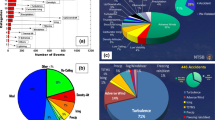Abstract
At microwave frequencies, rain is the main cause of degradation of the performances of satellite and terrestrial communications systems, essentially in tropical zones. The design and implementation of such systems involve the knowledge of the propagation parameters which govern link availability and service quality. Thus it seems desirable to develop prediction methods for deriving approximate attenuation statistics for any microwave link. In this paper, a rain induced attenuation model using the concept of equivalent path length is proposed for terrestrial and satellite links. As far as slant paths are concerned, the proposed prediction model uses a parameter, the value of which depends on the geographical zone. These values are given for zones where data are available : Europe, Australia, USA, Japan. The version of the model proposed for Australia (in its tropical part) can be extended to all other tropical zones of the world.
Analyse
A haute fréquence, la pluie constitue la principale source de degradation des performances des liaisons hertziennes terrestres et par satellite. La planification de tels systèmes nécessite la connaissance des paramètres de propagation qui régissent la disponibilité des futures liaisons et la qualité de service. Il paraît done souhaitable de disposer de méthodes de prévision pour en tirer des statistiques d’affaiblissements pour n’importe quelle liaison. Dans cet article, on propose une nouvelle methode de prévision des affaiblissements dus à la pluie sur des liaisons hertziennes terrestres et par satellite. Cette méthode est basée sur la notion de trajet radioélectrique équivalent. En ce qui concerne les liaisons par satellite, le modèle utilise un paramètre dont la valeur dépend de la zone geographique considérée. Ces valeurs sont calculées ici pour les zones où les données de pluie sont disponibles : Europe, Australie, USA, Japon. La valeur utilisée pour l’ustralie (dans sa partie tropicale) peut l’être aussi pour d’autres régions tropicales du monde.
Similar content being viewed by others
References
Houze (R. A.) Jr. Structure of atmospheric precipitation system: A global survey.Radio Sci., USA (sept.-oct. 1981),16, no 5, pp. 671–689.
Stutzman (W. L.), Dishman (W. K.). A simple model for the estimation of rain-induced attenuation along earth-space paths at millimeter wavelengths.Radio Sci., USA (nov.–dec. 1982),17, pp. 1465–1476.
***Ccir Report 564–3, vol. V. XVIth Plen. Ass. Dubrovnik 1986.
Misme (P.), Fimbel (J.). Détermination théorique et expérimentale de l’ affaiblissement par la pluie sur un trajet radioélectrique.Ann. Télecom., Fr. (1975),30, nos 5-6, pp. 149–158.
Moupfouma (F.). Improvement of a rain attenuation prediction method for terrestrial microwave links.IEEE Trans. AP, USA (Dec. 1984),32, pp. 1368–1372.
Ccir Data bank for line of sight and Earth-space propagation methods. Doc 5/3 (Rev. 1), 1986.
Ccir Report 338–5, vol. V, XVIth Plen. Ass. Dubrovnik (1986).
Olsen (R. L.), Rogers (D. V.), Hodge (D. B.). The aRb relation in the calculation of rain attenuation.IEEE Trans. AP, USA (1978),26, pp. 318–329.
Moupfouma (F.),Spanjaard (N.). Rain effects on microwave communications in Equatorial and Tropical regions.IEEE Global Telecommunications Conference (GLOBE- COM) (Dec. 1–4, 1986), pp. 197–201.
Pruppacher (H. R.), Beard (K. V.). A wind tunnel investigation of the internal circulation and shape of water drops falling at terminal velocity in air.Quart. J. R. Met. Soc. (April 1970),96, pp. 247–256.
***Ccir Report 721–2, vol. V, XVIth Plen. Ass. Dubrovnik (1986).
Moupfouma (F.). Empirical model of rainfall rates for microwave attenuation prediction in various hydrometeorological zones.URSI (Com. F) Open Symposium on Propagation: Remote Sensing and Communications. Durham University, New. H., USA (July 28th to August 1st 1986), pp. 9.6.1.-9.6.4.
Hogg (D. C), Chu (T. S.). The role of rain in satellite communications.Proceedings of the IEEE (Sept. 1975),63, no 9, pp. 1308–1331.
***Ccir Report 563–3, vol. 5, XVIth plen. Ass. Dubrovnik (1986).
Author information
Authors and Affiliations
Rights and permissions
About this article
Cite this article
Moupfouma, F. Rain induced attenuation prediction model for terrestrial and satellite-Earth microwave links. Ann. Telecommun. 42, 539–550 (1987). https://doi.org/10.1007/BF02994985
Received:
Accepted:
Issue Date:
DOI: https://doi.org/10.1007/BF02994985
Key words
- Electromagnetic wave propagation
- Microwave
- Attenuation
- Rain
- Radio-relay link
- Earth satellite propagation
- Statistical forecasting




